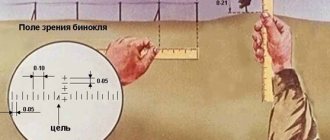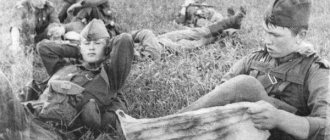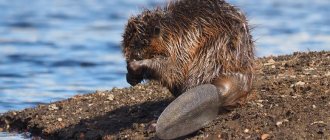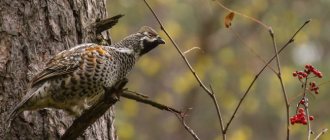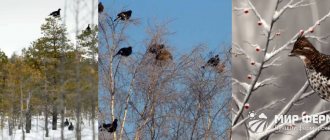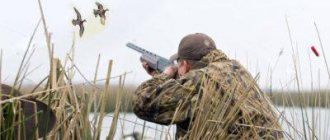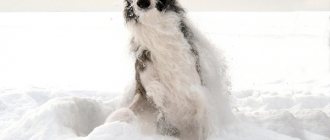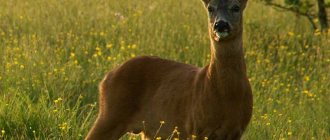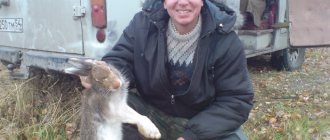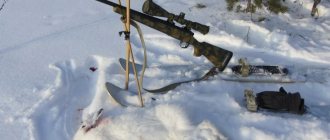A little about beavers
There are two types of beavers, one of them is called Canadian, the other is called European. The beaver is a common semi-aquatic rodent, an animal similar to other representatives of its genus. Among hunters, it is valued as a trophy animal, the taste of the meat is also not bad, beaver fur is very beautiful, durable, and lasts a long time. The coat color can be black, brown, light brown.
The animal's body length is 75-120 cm, height at the withers is 30-35 cm, although there are exceptions in both directions. Young beavers are always smaller than adult animals, and besides, their size greatly depends on their habitat and nutritional conditions. In swamps and slow rivers, animals are always larger; in fast rivers, they have small “dimensions” for ease of survival. In any case, this is the largest rodent, it can weigh up to 18-30 kg, swims and dives well.
Hunters are interested in whether a beaver can attack a person? This animal is quite large and can be dangerous, because its teeth are impressive. But beavers attack only out of despair, when there is nowhere to escape on land. To avoid an attack, you need to act carefully and wisely.
Beaver body structure
The animal's body is cylindrical (spindle-shaped) and has streamlined contours for optimal movement in water. Beavers live in the river; on land they are clumsy and slow. The head sits on a thick, short neck, large, in the mouth there are yellow or orange protruding incisors 20-40 mm long, chisel-shaped. Teeth have no roots; they grow throughout life, but they also wear out regularly.
The beaver's upper lip is forked and contains tactile hairs. A special fold above the animal’s lip prevents water from entering the mouth when swimming. The animal's vision is excellent, despite its small eyes, and there is a transparent membrane for water vision. The ears are small, barely noticeable from under the fur, and can be folded, covering the ear canal from water. The animal hears better than many other rodents and recognizes even the slightest rustle.

The animal's paws are strong, the front ones are smaller than the back ones. Fingers are tenacious, help to build and eat. On the hind legs there are webs between the toes, and on the second toe there is a “combing claw”. The animal's tail is well developed, has a flat shape, and looks like an oar. The tail is 25-27 cm long and 13 cm wide. It serves as the animal’s rudder when swimming and as a support on land. Under the tail is the famous beaver stream, which is a special gland with an unpleasant odor.
Beaver hair
The entire body, except the tail, feet, and nose, is covered with dark-colored hair. The shade may vary depending on the beaver’s habitat: in the European zone, almost black animals are often found; among the Canadian population, the animals are predominantly brown and chestnut. Young beavers have a more intense color. Each animal's fur consists of 2 types of hair:
- guard hairs - sparse, coarse, hairs, longer than the rest;
- downy (underfur) – thick, silky, soft fur.
Air accumulates between the first and second hairs, which prevents water from wetting the animal’s skin. Also, the wool does not get wet due to fatty lubrication. A healthy beaver has beautiful, shiny fur, while a sick beaver has dull, wrinkled fur. The highest fluff is on the ridge and nape (up to 30 mm for downy hair), slightly less (up to 22 mm) on the neck and sides. At the base of the tail, on the cheeks, and belly, the down is 15 mm. Guard hairs can grow 3-6.5 cm in length.

Beaver fur maturation and molting
According to the rules of Russia and most CIS countries, the duration of beaver hunting is not limited. You can shoot it all year round, but winter fur is of the highest quality. It is in winter that the underfur is the densest. Beavers are hunted in the middle of the winter season, when it is planned to remove long guard hairs. If the fur will be used in its natural form, it is worth taking it in the fall.
October animal fur is especially valued among autumn animals, when the underfur is already thick and the guard hairs are not overgrown. In general, traditionally the beaver hunting season in the Russian Federation opens in November and ends in the spring (March). In Eastern Europe, the hunting season opens in September, but the quality of the skins is considered poorer. The beaver's molting periods are as follows:
- spring – April-May;
- autumn - end of August - mid-September.
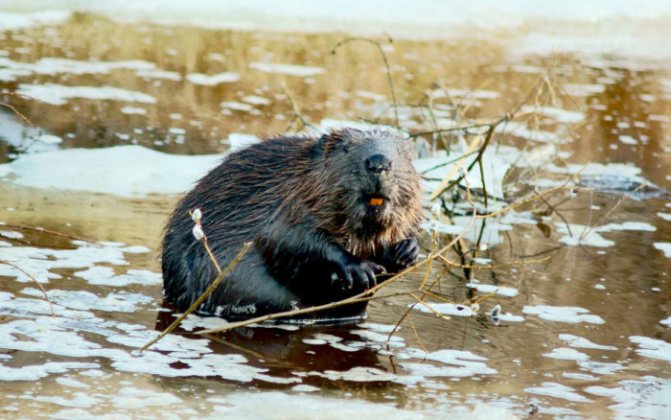
In summer, there are almost as many guard hairs on the skin as in winter, but there are 2 times less down hairs. Therefore, the skins are seriously inferior in quality to winter skins and are in little demand. Fur in spring also has less covering hair, which is associated with spring molting.
Beaver range and habitat conditions
Beavers live only in the Northern Hemisphere, although they previously lived in Asia, the East, and California. They are usually drawn to forest areas where there are suitable bodies of water. The beaver lives on small rivers, old lakes, abandoned canals, which are overgrown with aspens, birches, alders, willows and shrubs. Rivers no deeper than 2 meters and up to 30 meters wide are ideal for the life of beavers. Animals love the banks to be covered with sedge, reeds, and water capsules. Three beaver families usually settle along 2 kilometers of shore.
Beaver nutrition
What food is good for a beaver? The animal eats plant and wood food and eats almost all plants. In summer it is grass, stems, dug roots. If there are vegetable gardens nearby, beavers can steal vegetables and eat cherry and apple bark. In summer and autumn, the animal is busy making supplies for the winter, but usually does not go further than 100 meters from the dam. More often, animals store young wood:
- willow;
- aspen;
- bird cherry.
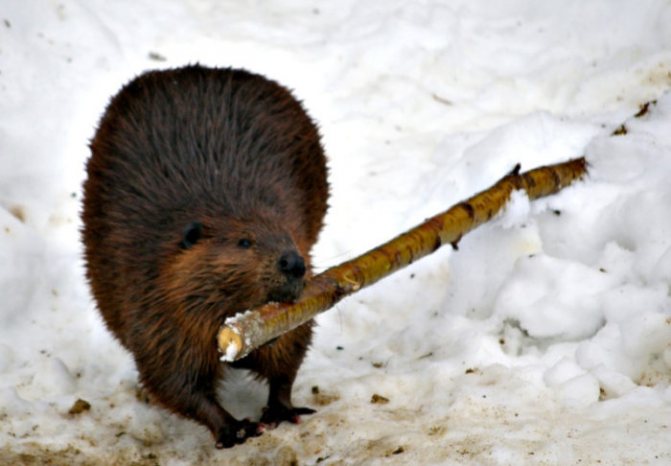
The petioles are carried by the animals to the dwelling, deposited in the water closer to the bottom of the river, and the reserves for a family can amount to up to 2 cubic meters of wood. In cold weather, beavers feed underwater - they drag branches into the hut and gnaw them. If necessary, thicker branches are used for harvesting. Dry wood is transported in different ways. Over short distances, animals deliver food by dragging, moving backwards. Approaching a longer distance is done by walking forward, dragging the branch from the side. Large branches are cut by the entire beaver family. Animals make less serious reserves if there are a lot of plants in the reservoir, even in winter.
Beavers begin to feed in the spring and go outside in March. Animals look for twigs, gnaw young shoots, old twigs, even withered plants. If there is little food, the beaver can, with rest breaks, knock down a large tree, then eat its upper branches.
Beaver breeding
Individuals are considered sexually mature from the third year of life. At what time do beavers rut? Usually these animals begin to look for a mate in February-March. They leave their homes, actively swim, walk in the snow, and do not forget to mark their paths. It is at this time that you can see the marks of a beaver stream on the snow - brown spots, streaks. After water mating, the female animal bears offspring for 105 days and gives birth to 1-5 beaver cubs by the end of spring.
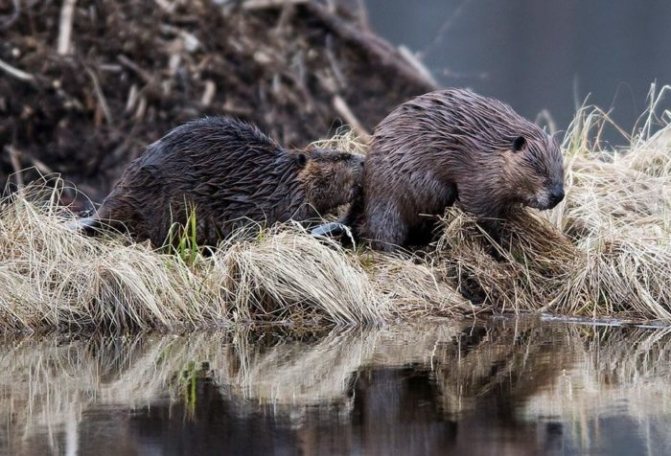
The cubs eat their mother's milk in the first month, then begin to eat plant foods, and by 8 weeks the beaver completely stops feeding them milk. By this time, the beavers can gnaw on young twigs themselves, and by the end of the 2nd year of life they completely leave their mother. Typically, young animals disperse over rather long distances, up to 150 km from their parents. In total, up to 10 animals can live in one family, but usually there are no more than five.
Fishing with traps
Hunting beaver in winter with traps is a legal and effective way of hunting. That's why he is popular. Traps are divided into 2 types:
- trace (pinching);
- passing (pressing).
The most popular methods of catching beaver in winter are “with a broom” and “on chains”. How to set a trail trap with a broom:
- Take a small log (spruce, fir, pine), 2 simple sticks or a medium-sized spear, a bunch of aspen twigs. The sticks will be used as support; their length should be slightly greater than the depth of the hole.
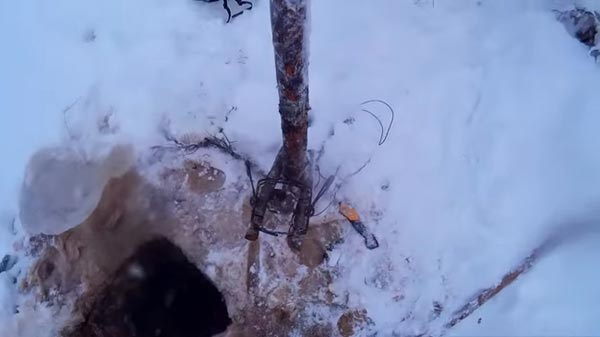
- Install a support and position the log perpendicular to it.
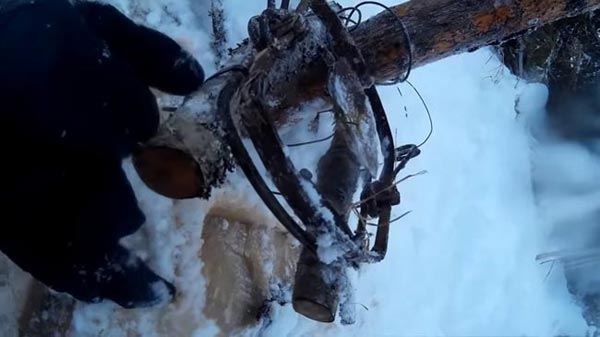
- A trap is attached to the base of the support, from below. Fixed with ties or plastic clamps.
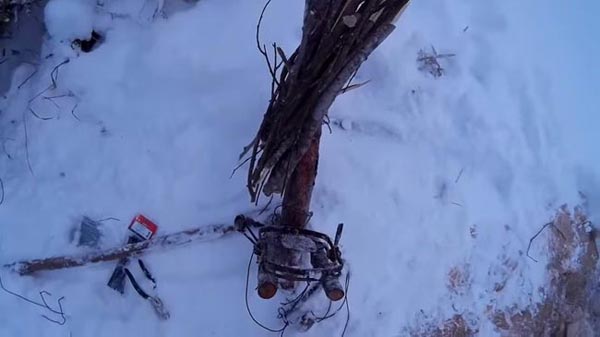
- A broom made of aspen twigs is attached higher to the log. It should be positioned so that the beaver, gnawing branches, rests its paws on the trap.
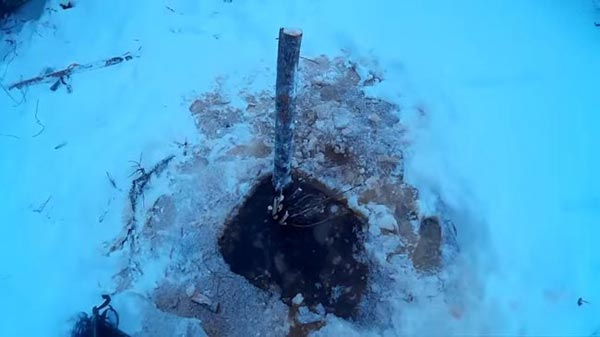
- We release the finished structure into the hole. Cover the hole from freezing and fill it with snow.
Features and techniques are clearly shown in the video.
How to set a walk-through beaver trap on chains in winter:
- You will need the KP250 and KP320 models (domestic production). As bait you need an aspen peg with pointed ends. Its width should exceed the width of the trap, i.e. 30-35 cm. In addition, metal chains or a cable are needed.
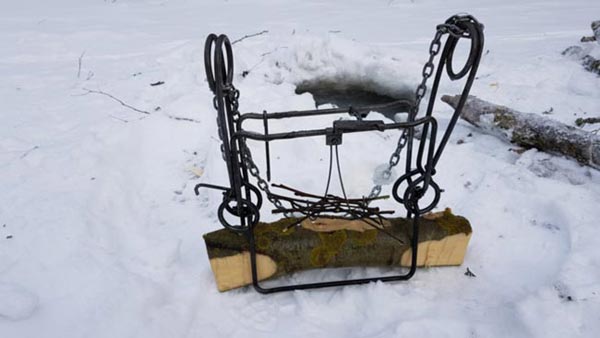
- Make a hole in the ice not far from the animal’s home. It should be almost the same size as the trap, but it should fit freely into it. The bait is placed between the lower brackets (under the guard).
- A pole is installed across the hole. It must be thick and strong enough to support the weight of both the trap and the animal.
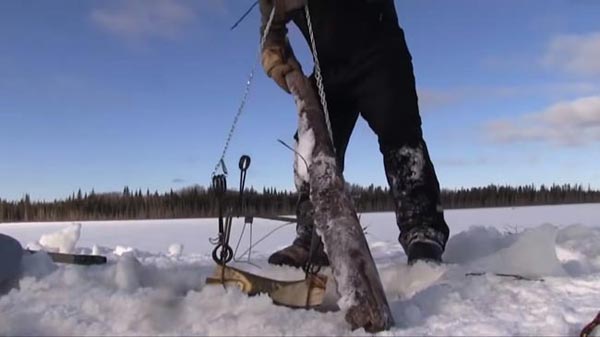
- Chains or a cable are attached to the trap (by spring rings on the inside).
- The other end of the chain is suspended from the thickest part of the pole.
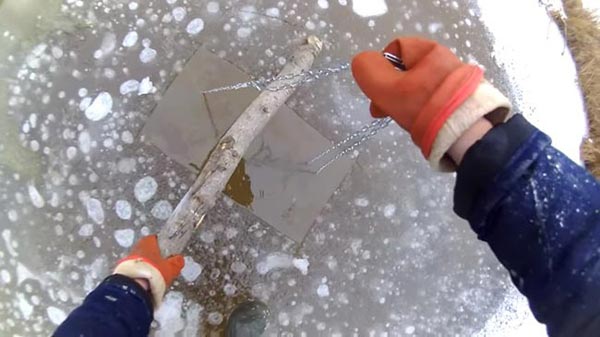
- A trap is set in a fairly deep place. The structure is immersed in water. The trap is placed in such a place that it does not get caught on the bottom or freeze into the ice - and at the same time so that the rodent cannot go around it along the bottom or sides.
It is most effective to install traps in the channels that burs use to move. During the cold season, the animal actively prowls in search of food. Most often it appears in those places where it stores supplies, less often it comes to the surface. It is best to install the trap where the passage is narrower - at the entrance to the burrow, on the turns and meanders of beaver passages. Traps are checked 1-2 times every 7 days.
Trapping beavers is a legal and humane method of hunting. The operating features of the device and installation technique are such that the animal most often dies immediately.
Beaver catching video:
Beaver construction activity
You can see what a beaver's home looks like in the video - the animals literally adapt the surrounding area to themselves. Beaver buildings vary in purpose and shape, and largely depend on the type of habitat. The easiest way for the animal is to install temporary housing where the beaver lives in the summer. In a place hidden from the light and from prying eyes, a “nest” is set up in a hole, lined with grass and leaves. When in danger, the beaver easily reaches water. If a den is made under the roots of a tree, it is called a "coble", usually made by young animals after leaving the house. Animals have several types of dwellings, more complex in “architecture”.
Huts
The hut is usually a more “advanced” coble, located under a tree on the shore of a reservoir. Gradually the animal improves its housing, builds on top of it, making a multi-story hut. It expands under the water, and part of the soil near the shore is removed. Usually, huts are built by those beavers that cannot build burrows due to the terrain (proximity of groundwater, swamps ).
Externally, a beaver's hut looks like a pile of sticks, some of them sharpened. Despite its apparent fragility, the hut is very durable; a person can even sit on it without the risk of falling. Inside there is a chamber with a den and beaver beds. Several passages go into the water from the animal’s hut, some in the shape of a loop, others straight. All holes are underwater, and there are no holes outside. In the fall, the animals repair their huts - sealing cracks and crevices with silt.
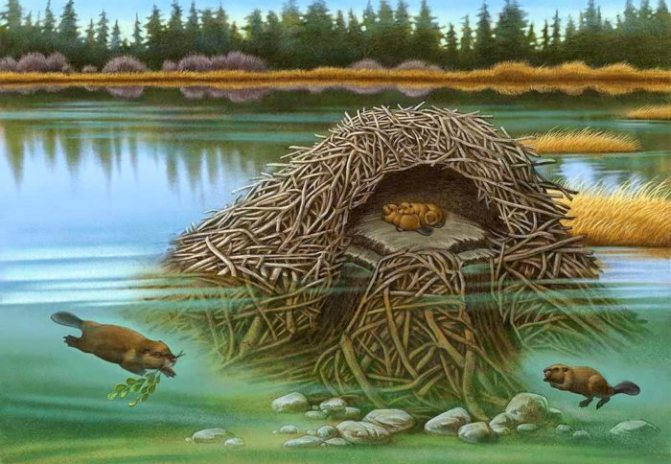
Burrows
Huts are not the beaver's main home. He prefers burrows and, if possible, builds them. An animal's burrow is a straight passage, starting below the water level, entering the shore, deaf inside. It ends in a wide chamber with a lair. You need to look for the entrance to the hole under branches hanging over the shore, although it is usually located at a considerable depth. At the bottom of the reservoir there is a pile of soil - a trace from a dug hole, and there are also the remains of the animal's food.
The underground passage is built in such a way that only the hole remains flooded, and the rest of it goes up. As a result, the animal’s lair may be under a thin layer of soil, and over time it often collapses. In this case, the beavers immediately begin repairs using branches, filling up the hole.
Channels
The canal system is also built by the beaver family; it is required to ensure safety from strangers and ease of feeding. First, beavers make a path through marshy areas, which then fills with water. Then the beavers deepen the trail, tearing it up by half a meter or more. Such channels lead to beaver housing; sometimes they are covered on top with branches and twigs for the purpose of camouflage.
Dams
Why do beavers need dams? Such structures are usually built by animals on drying up reservoirs and small ditches; they are designed to maintain the required water level. Beavers place dams downstream from where they obtain food and permanent residence, choosing the narrowest space. If water ruins the building, the animals will rebuild it from branches, stones, or any material that the river brings. It is also necessary to build up buildings due to an increase in the level of the bottom, which occurs due to the deposition of silt. Overnight, a family of animals easily builds a dam 1.5 meters long.
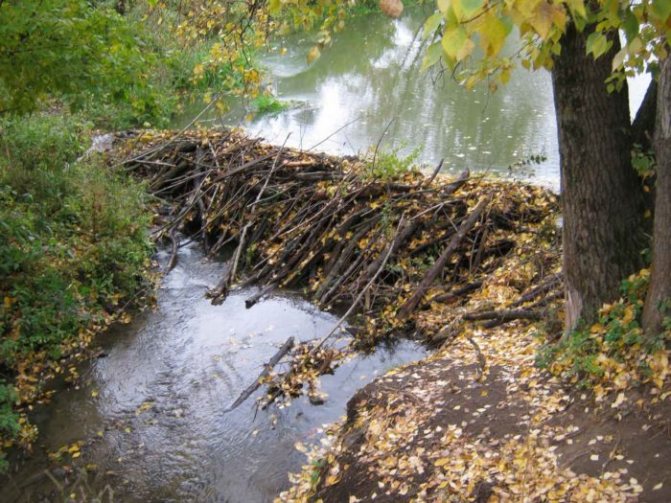
How to set a beaver trap: installation rules
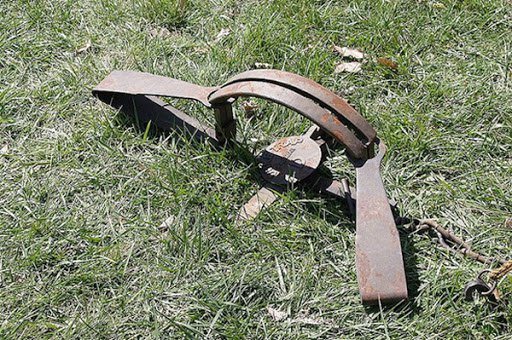
Beaver traps can be installed at the bottom of a reservoir, on a dam, and also on coastal strips. If the trap is placed on a dam, then you first need to dismantle the structure on top. This is necessary to eliminate a small leak. The appearance of such a “flaw” will force animals to prevent it by coming to the surface.
However, you should not leave the trap near the leak, otherwise it will become clogged with dirt or branches that the beavers will use to repair the dams. If the trap is located near the shore, it must be attached to a log. The log itself is placed in the middle of the river. To install traps, you need to create a platform for its stable location.
Some hunters take the captured beaver entirely and cut it down at home. If several beavers are caught, or their meat is not needed for food, they are slaughtered on site.
The skin is removed layer by layer in two ways:
- quick shot (with deboning);
- gradual, meticulous, not requiring additional degreasing.
If necessary, the meat can be cut into pieces. Often, professionals take only a stream of beavers.
As for the hunter’s equipment, the following can be noted: as in the case of installing any trap, you must take with you an ax, wire, knife, and pliers.
Previously, hunters used only saucer traps. They are quite attractive, easy to use and install. Their main disadvantage is the number of fractures and crushes of the animal’s paws, which is associated with inability and inattention to setting the trap.
These days, pressure traps are more popular. A properly installed trap catches the animal near the head or by the neck and body. The rodent dies quickly, regardless of where the trap was set. It is important that they do not injure animals or damage their fur.
For the trap to work, you need to study in advance the habits of rodents, their living conditions, and the main features of their habitat - rivers, lakes.
When checking the reliability of a trap, you need to look at the quality of the alert. Then the strength of the springs and arms is carefully checked. You also need to make sure that the trap has no signs of corrosion, cracks, holes or other flaws.
The extraction of the largest rodent has certain characteristics that depend on the season and weather conditions. On a warm day, the trap is left at the entrance to the beaver's hole or lodge. Sometimes a trap is placed in a place where beavers feed.
Beaver daily and seasonal life cycles
Beavers are active at night, and during the day they most often rest in the house. But often in the daytime they also come out if the situation around is calm. Males can bask in the sun, get food, and in general, their routine is constantly changing and depends on the time of year. In the evening, the whole family leaves their home, swims in the water, eats, and gnaws on trees. Before sunset, they often play and dive, having previously greased their fur. By morning the beavers return to the house.
In winter, animals spend more time in a hole or hut, but go to the toilet outside them. If there are holes in the water, beavers come to the surface and walk on the snow; if there are no holes in the ice, they can gnaw through them. In the spring, during the rut, males often have bloody skirmishes over females. Beavers usually start digging new burrows no earlier than the second half of summer. At the same time, the renovation of old dwellings and the preparation of feed begin, which last until late autumn.
Traces of beaver activity
An experienced tracker knows not only how to hunt a beaver, but also the peculiarities of its life activity, which does not pass without a trace. Usually, when examining the coastal zone, you can immediately notice huts and dams, but burrows are not so easy to find. But an inspection of coastal grass, plants and trees will indicate that beavers live nearby - there will be remains of bark, roots, and twigs lying around.
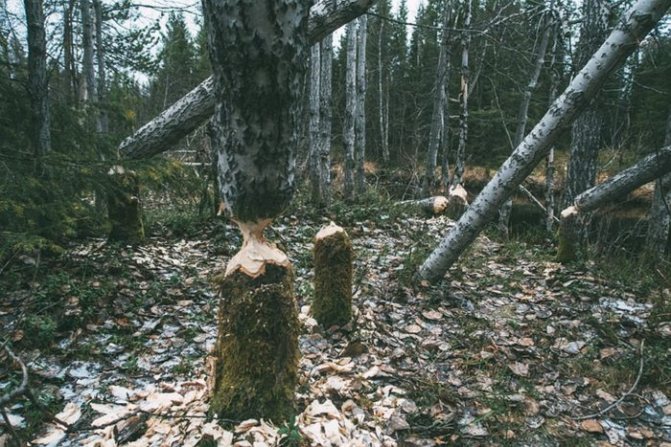
In autumn you can see felled trees, stumps with cone-shaped tops, gnawed like a pencil. The lower branches remain nibbled, as if cut with a blade. If the plants hang over a pond, the beaver eats them without leaving the water, which is also noticeable. On wet ground or fresh snow, you can sometimes see beaver tracks, between which there is a wavy path - a mark from the tail. The footprint of the front paws is star-shaped with indentations at the ends, while the footprints of the hind paws are fan-shaped, with a dimple from the heel. Only a specialist can determine the presence of beavers by looking at their droppings. The droppings have the shape of a walnut and contain a lot of sawdust and scales. Beaver urine is red-brown in color.
Beaver hunting methods
Every beaverkeeper knows at least 3-4 methods of hunting. And these are just the main ones, and there are even more of them if you take into account the terrain, the time of year and the use of special equipment.
From the approach
With this method, the beaver is waited on the trail after its morning fattening. The animal behaves rather clumsily on the ground and this should be taken advantage of. Just don’t let him go in any way, much less let him near the reservoir.
There is another way when a breach is made in the dam. After this, all that remains is to be patient and wait for the repair team.
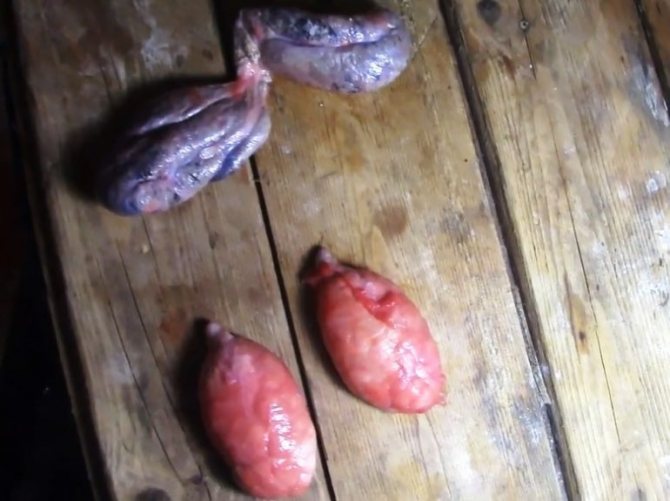
Peeled beaver stream and wen
Ambush
Not far from the huts, on the leeward side, they look for paths and set up an ambush. A very good option would be to build a nest on an elevated site. Beavers have no enemies attacking from above, so they do not expect danger from there and pay almost no attention upward.
With this option, it is possible to fire a shot at a fairly short distance. Having seen a beaver, it is blinded by a sharp light and has 1 second to shoot. In an unexpected harsh light, the beaver freezes, exposing himself to a bullet.
Target – head, neck, shoulder blades.
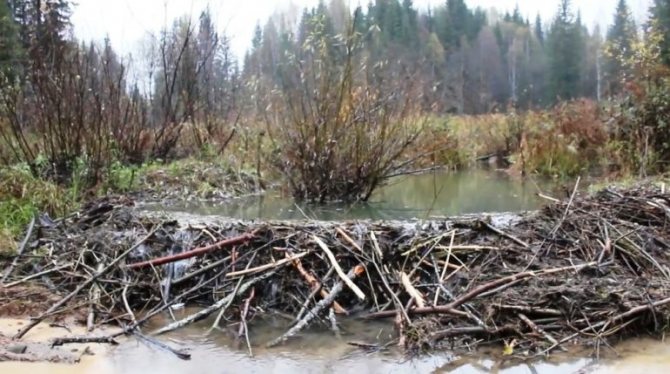
From the boat
This hunt requires certain skills and great patience. When hunting, they do not use oars or improvised means. Talking is absolutely unacceptable. Partners discuss conventional signs in advance; in the process, one hunter shines a lantern, the other holds a gun at the ready.
It is not necessary to set up an ambush in open water - if the boat is tied to the shore, the view will increase significantly: the beaver can be seen both swimming and moving along the path.
Types of spring and autumn hunting
To successfully search for a beaver, the hunter must have dexterity, dexterity, and the ability to correctly imitate the sounds of the animal with a decoy. You need to have a weapon, a hunting license and the necessary equipment with you. They rarely go hunting beavers with a dog, although huskies are good at tearing apart their burrows. There are different types of beaver hunting.
In the evening from an ambush
If a beaver's hut is discovered, you need to find a high ground and make a hideout with your own hands. Why is shelter on a hill better than usual? Beavers do not expect to see enemies attacking from above, so they will not be afraid and will not look up. When placed in a hiding place, you cannot smoke or use any cosmetics - the animal will immediately smell a foreign smell. In this case, shooting is carried out as the beaver emerges from a distance of about 10-11 meters.
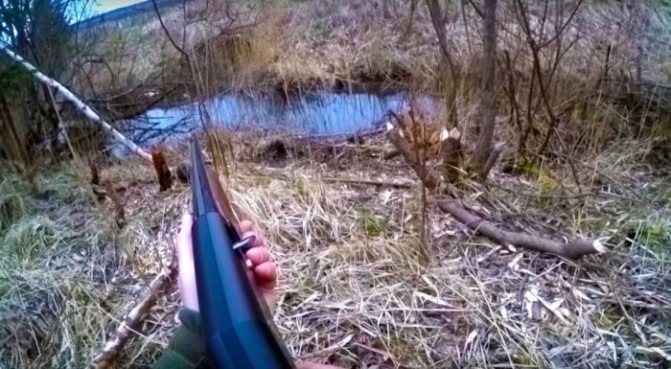
From the approach
They hunt from the approach at dawn in early spring. At this time, the animal family most often comes from dinner. When the largest animal (male) comes ashore, you can shoot. Due to the slow pace of the animals, the shot is usually successful.
From the boat
The boat is used in beaver hunting only at night and when there are at least two hunters. The engine is turned off, silently sliding towards the huts. One hunter shines a lantern at night, the second makes a shot.
The nuances of hunting at different times of the year
Beavers are hunted using traps in autumn and winter. In summer, the law prohibits beaver hunting with traps. With the arrival of autumn, these mammals are actively preparing food for the winter. And this goes well with the use of any traps throughout the rodent habitat. The only exception is bad weather, when heavy rains destroy roads, water bodies begin to overflow and the water level rises significantly. In autumn, beavers are more well-fed, and it is possible to obtain a large amount of valuable meat. In winter, it is also possible to hunt beavers by installing devices in their habitats, but you need to know some nuances.
Weapons and equipment
Choosing the right clothes, shoes, and other equipment is very important. Be sure to take a mosquito net if hunting is carried out in the summer or autumn - you cannot use aerosol repellents due to the pungent odor. Shoes (boots, sneakers) should be waterproof; it is better to wear boots, as you may need to go into the water. To store the prey, take a strong plastic bag, which is then placed in a backpack. For night hunting you will need a high-quality flashlight with a battery, for day hunting - binoculars.
Beaver gun
The gun can be smooth-bore or rifled; it is better to take a double-barreled shotgun. Even a small carbine (small-caliber weapon) will do, but the accuracy of the shot may decrease. The beaver is a cautious animal; you need to kill it with the first, or maximum, second shot, otherwise it will end up in the water and will be irretrievably lost to the hunter. In general, you need to choose a gun based on the size of the person himself - the taller and stronger he is, the larger the weapon can be.
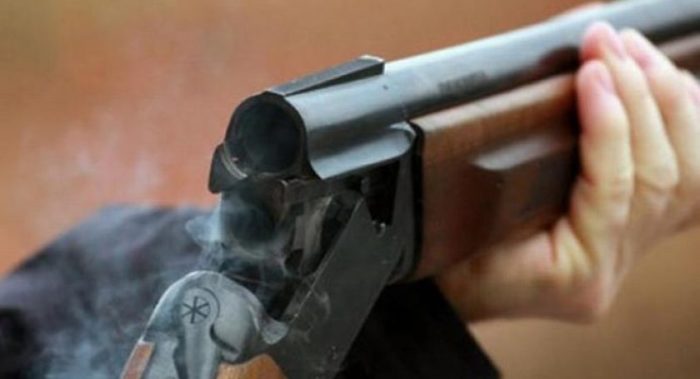
According to reviews, semi-automatic carbines, pump-action shotguns, and three-barreled shotguns perform worse - they are less convenient for shooting from an ambush. You can shoot from 12 gauge, but experienced hunters prefer 18 gauge. A new feature is beaver hunting with a bow or crossbow; its popularity has now increased greatly.
Fraction number
Shooting with shot number 3-5 is not very correct. Often, hunters kill beavers with this type of shot if the animal is caught by accident, for example, when hunting a duck. In this case, many animals remain wounded and die in the water after a certain period of time, or their skin is damaged and the meat is filled with pellets. The same result is achieved when shooting with five from a short distance.
It is considered more practical to shoot with 6.5 buckshot cartridges. It penetrates the skull well and smooths out the flaws of inaccurate aiming. Coarse shot (numbers 6-8) works in a similar way. Therefore, at a distance of up to 20-30 meters they shoot with buckshot, large shot. From a greater distance, with an optical sight, it is better to use bullets.
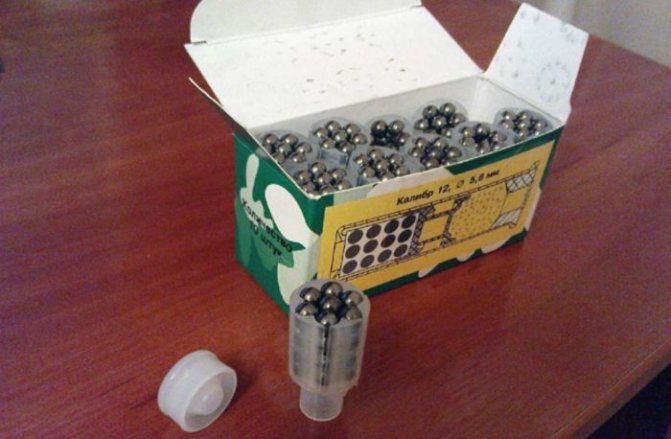
Boat
Hunters buy rubber or iron boats to catch beavers; each type has its own advantages and disadvantages. Here are the advantages of a rubber boat:
- ease of rowing, noiselessness, absence of creaking oars when moving;
- the ability to bring it deflated in the trunk of any car;
- moderate cost.
The disadvantage of a rubber boat is low safety - beavers often leave sharp branches, trunks, and gnawed stumps, which can tear the vehicle. Any snag is dangerous, especially in the dark. The low weight of the boat also serves as a disadvantage - it can be carried away by the current, and when fired, the recoil causes the vessel to rotate. It is difficult to finish off a wounded beaver in such conditions.

Iron products can withstand the flow and are stable on water. A battery and a flashlight are easily mounted on the sides. The mass of the boat is large; a shot will not spin it. There are also disadvantages - a booming bottom, creaking, noise when moving, difficulty in delivering to the destination.
Hunting process
For autumn beaver hunting, the hunter will need:
- Weapon;
- Spotlight, battery-powered headlight, flashlight;
- Comfortable and waterproof clothing;
- Mosquito net, since mosquitoes and midges may still be present near water;
- Plastic bottles for marks of a successful shot;
- Carcass bag - a wet beaver is quite heavy, the backpack is small for it;
- Boat. This is for areas where beavers have settled on high water and it may come in handy. On rivers, beavers are often hunted from boats;
- A pole with a hook, a hook. This is also for moments when the animal needs to be taken out of the water.
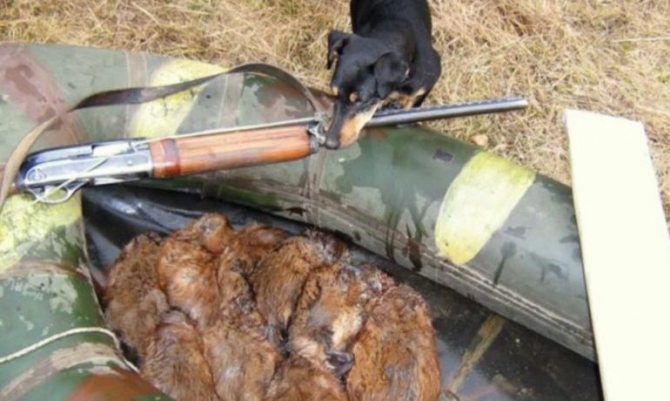
Having approached the hunting site, they determine the optimal ambush option: from the hut below or above. Proper camouflage and slow, smooth movements make the hunter invisible to beavers.
The optimal distance to the target is considered to be approximately 20 meters, but the closer, the better. A weak-sighted beaver will not be afraid of a motionless hunter and this is an excellent chance to let the animal get closer.
The most lethal place is the head, then the neck. For a successful result, they shoot with a lead - they accompany a swimming beaver. After the first shot reaches the target, the beaver experiences severe shock and freezes for 2-3 seconds. It happens that one shot is not enough; after experiencing the shock, the beaver begins to move to dive.
Trophies are usually collected early in the morning, guided by floats
At this moment, you need to have time to shoot a second time, finishing off the animal. The process lasts 3-5 seconds, there is no time to reload, and you can miss the beaver - that’s why a double-barreled shotgun is the best option.
It should be taken into account, especially for beginners, that the beaver is tough when wounded: even if seriously wounded, it will have time to hide in the water. There have been cases when an animal in serious condition reached the water almost 25 meters away.
It’s not difficult to catch up with a beaver on the shore, but if he dives, there may be problems: he will have time to reach the hole or get caught on a snag, then that’s it. If death is found simply in the water, then the carcass always floats up, you have to wait from 30 minutes to 3 hours. In this case, the place is marked with a bottle float for subsequent inspection with a hook.
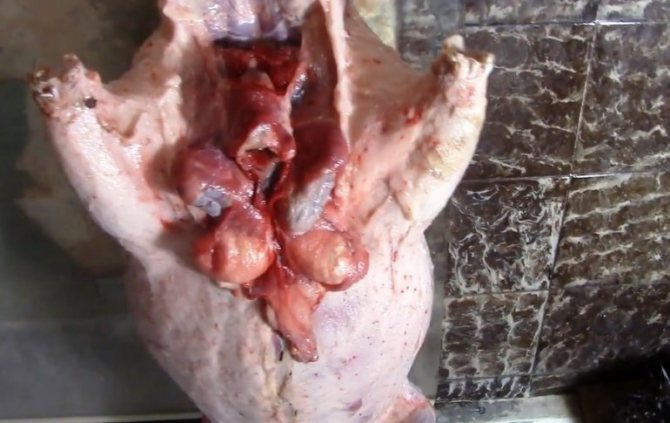
Beaver stream and wen
Rules for hunting with a gun
In order for the hunt to be successful, you need to develop a strategy in advance, as well as correctly carry out the preparatory activities.
Preparing to hunt beavers
When constructing a hiding place, it is necessary to clear the soil of twigs and twigs that can cause cracking. Also remove rustling leaves. You should sit quietly, without making sounds, so as not to frighten the animal. Beavers always appear unexpectedly, so the gun must be ready. Unlike other smells, beavers are not bothered by the smoke of a fire, and they can light a fire.
Tactics for catching a beaver
It is best to shoot when the animal comes out of the water onto the shore. Otherwise, even a seriously wounded beaver will go into the water, swim to the house, survive or die. Therefore, the accuracy of the first shot is very important. To be able to quickly make a second shot, take double-barreled shotguns, which do not need to be reloaded.
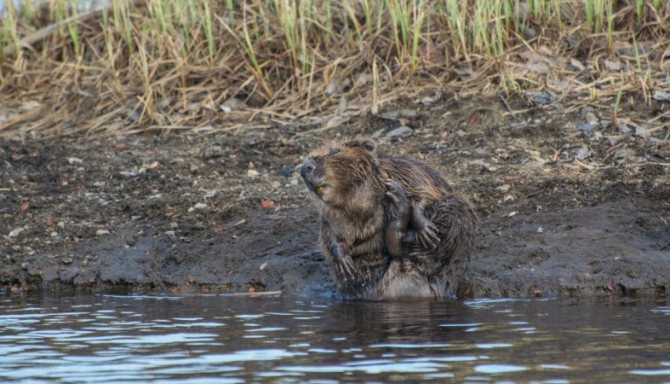
Shooting a beaver
They try to bring the animal closer so that the shot is more accurate. It is better when the angle of entry of the bullet into the water is large. The killing places of the beaver are the head, spine, front part of the body, and shoulder blades. When hit by buckshot, the animal freezes from pain shock, and you can have time to fire a second shot. If the animal still manages to go under water, you should wait 30-60 minutes: when the beaver dies in the same place, it emerges within the specified time.
Safety precautions
A slightly wounded animal on land is capable of attacking a person, because its teeth are quite dangerous. Therefore, it is important to maintain the shooting distance, do not shoot at bushes, and do not touch cubs or pregnant females. The gun must be transported unloaded and disassembled.
Removing a dead beaver
A dead beaver must be removed from the water immediately, otherwise it will be carried away by the current. For this purpose, high boots or a long beam are used, which is used to hook the body like a hook.
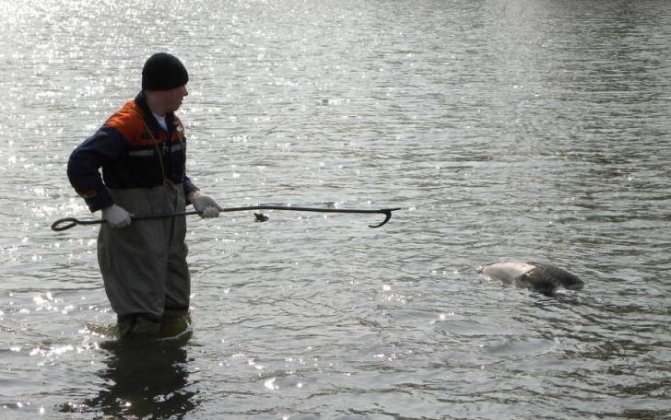
Making odorous beaver bait
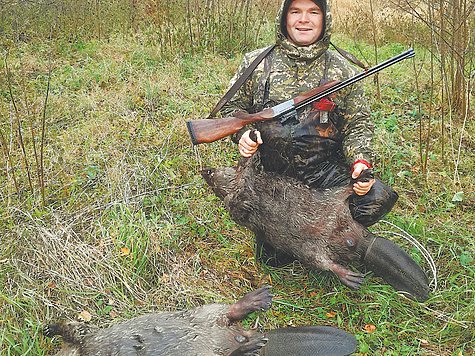
Photo by the author.
It is sometimes very simple to catch a beaver with a gun - the beaver itself swims to the feet of the hunter.
And sometimes everything turns out the other way around: a beaver swims along the other shore out of range of a targeted shot, swims nearby, but constantly dives, stomps somewhere in the bushes and coastal voids, and is not visible.
The success of this hunt depends entirely on the right location and the skill of patient and silent waiting.
Sometimes you find such places, and if you don’t make some noise, you can close the permit in one evening. And it happens that there are a lot of beavers, but the place is not the best.
Just for such cases of hunting in inconvenience, there is a way to lure the beaver to an open place on the shore.
The method is based on the territorial isolation of the beaver family, which constantly adheres to one area and does not tolerate strangers.
Parents make odorous marks around the perimeter of their site (signal mounds, castor mounds). It looks something like this. The beaver swims to the place, grabs dirt and coastal vegetation with its front paws and forms a mound of them 10–20 cm high and 20–30 cm in diameter.
Next, he compacts it and marks it with three types of his own secretion: urine, wen secretion, and jet. Thus, this place transmits the odor signal to other individuals. What exactly this signal carries is a complex question.
Scientists say that it contains all the information about the owner of the site for “friends” and “strangers”: gender, age, readiness to mate, feeding habits, illness. All this is an invisible message to other families. What effect does this have on “foreign” individuals?
First of all, any beaver seeks to explore this place. The beaver swims up, sniffs the mark, if it is old enough and claims this area, repeats all the actions of its predecessor, mixes the dirt, makes a mound, and leaves its odorous mark.
A territorial dispute ensues between “friends” and “strangers,” which inevitably ends in “fights without rules.” The results of these battles can be seen in the scars on the flesh and the tails deformed from bites.
An observant hunter can make an imitation scent mark and lure the beaver.
This method has been used since ancient times when hunting with traps; I think even the first beaver trappers used it. The method can be successfully used for rifle hunting in difficult situations. To do this, you need to choose a place where you want to lure the beaver out of the supports.
The hunter repeats all the actions of the beaver on the signal mound. Using a sapper shovel, he splashes the dirt onto the shore, smoothes it out, forming a grooved, slippery slope. Next, you need to make a mound on the shore area, mixing dirt with fallen leaves and grass.
An odorous beaver bait is placed on the top of such a mound. The artificial opening and the shore are doused with water, which will distribute the bait along the shore. It is advisable to apply this mark from the water, if the depth of the reservoir allows.
When approaching a place, you should touch surrounding objects and plants with your hands as little as possible. The smell of “housing” is already familiar to the animal at the genetic level, and can scare away the seasoned one.
After applying the scent mark, the hunter returns to his hiding spot along the same route. Next comes His Majesty's patience.
Bait plays an important role in this method. It can be bought in a store or from private manufacturers. Or you can’t be too lazy to do it yourself. Fortunately, there is nothing supernatural in this potion. You only need a stream of beaver and its wen, everything else you will find in your housewife’s kitchen (see recipe).
I must say right away that I do not use young beaver stream for my baits. They are rather weak and lack, as it seems to me, the entire palette of smell from an adult, mature individual.
To dilute the bait, you can use alcohol, but it is too fluid and disperses the smell strongly, while glycerin, on the contrary, makes the setting more accurate, concentrating the smell exactly on the hatch. The secretion of beaver wen is also necessary for bait.
It makes it more viscous and fixes the smell at the site of application. Well, “spices” in the form of ground cinnamon, cloves... They are needed to enhance and change the smell of the beaver; such a smell is perceived by any beaver as “alien.” This bait is applied to the place with a total volume of ½ tsp. and spread with a stick.
In conclusion, I must say about the advantages of this method. It is suitable for luring beavers out of trouble when hunting with a gun and is indispensable for trap fishing. The method forces the beaver to swim on horseback to a specific place.
If the hunter has enough patience, the beaver will come ashore. I think that when approaching the signal mound, the animal’s caution also becomes dull, because the smell of a stranger takes time to study.
The bait itself retains the smell for a long time; you can go hunting on the second and third days to the same place without updating the signal mound.
SMELLING BAIT FOR BEAVER
Heat 1 glass of glycerin in a saucepan until smoke appears, add:
- ½ tsp. ground cinnamon
- ½ tsp. ground cloves
- ½ tsp. ground nutmeg, cook over low heat for 10–15 minutes.
- ½ tsp. melt the beaver wen secretion, stir, let cool, add:
- 1 cup of beaver stream, passed through a meat grinder twice
Leave for 30 days in the shade, then pour into small containers.
Andrey Ponyaga October 12, 2020 at 01:19 pm
Features of winter animal hunting
In winter, when the beaver's pelt is most valuable, it is most difficult to catch. Animals sit in burrows and rarely come to the surface. Only in February, when food supplies are running low, do they begin to walk around the area regularly. Huts covered with snow are not easy to find and it is better to spot them in the fall. This way, you won’t have to figure out the beaver’s habitat by wandering through the snowdrifts.
Some hunters use snares (traps) to catch beavers in winter, although this method was previously considered poaching. It is worth checking them daily, and if a cub or a pregnant female is found, immediately release the animal. They set traps not far from the dams, covering them with twigs and dry wood. You can add complementary foods in the form of aspen and alder branches.
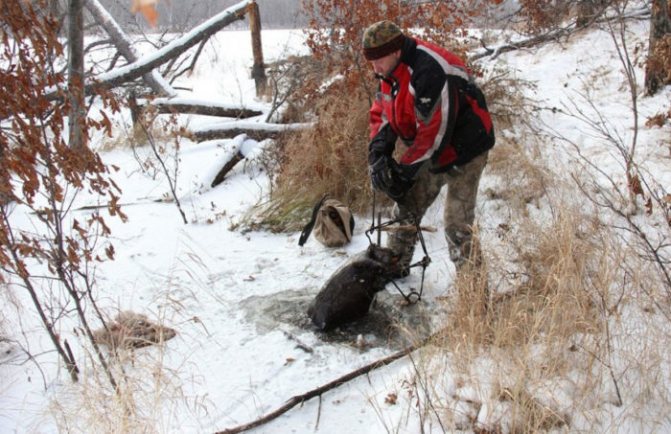
Another option for catching a beaver is to install self-catchers: loops, traps. The loops are placed under water in the direction of the beavers' movement, which can be easily seen by the air bubbles. They make an artificial wormwood, lower a log with a tied loop, into which the beaver will fall as it moves through the water. You can also build other traps yourself - for example, a cylinder 30 cm in diameter, 1 m long, made of iron mesh. One side of it should be blank, the other should have a door that opens inward. Once trapped, the beaver will no longer be able to escape.
When can you hunt beaver with a gun?
Regardless of which hunting method you choose, you should familiarize yourself with the basic rules for this event in advance. For example, it is important to know the timing when the hunting season officially opens. The most accurate information can be found in the local administrative center (where you received your hunter's license), because in each region the authorities can establish their own hunting rules based on local climate conditions.
As a rule, the beaver hunting season opens in March and lasts until mid-July. In August, it is strictly forbidden to shoot animals, as they begin to play mating games, reproduce and raise offspring. After this, the season usually opens again in October. As for winter hunting for beavers, it is also strictly prohibited, because the hunter can prevent the whole flock from surviving the cold season.
It is also important to remember that you are only allowed to shoot wild animals that are outside the shelter. It is strictly forbidden to destroy dams and huts in order to obtain even a wounded animal. Of course, killing pregnant beavers and their offspring is prohibited, as is setting traps near the entrances to the shelter. All these actions are considered poaching and are strictly punishable by law.
Hunting permit
You cannot hunt beavers without a special license. Legal entities can obtain a one-time administrative license to shoot animals. Individuals receive the same or long-term license. To apply, you need an application, a passport, a hunting license, and you must first pay the state fee. Licenses are issued from the beginning of October, until this time you can explore the beaver habitats and prepare for the hunt. You should not engage in poaching methods of obtaining animals; honest hunting is much safer and more interesting!
Hunting from a boat is the most common method
Now you know whether it is possible to hunt beaver in the spring. However, to ensure that the event not only does not bring problems with the law, but also ensures a good trophy, it is recommended to choose the optimal hunting method.
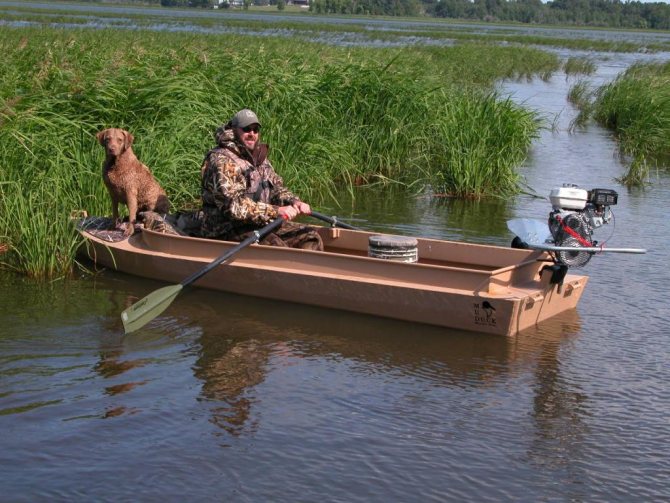
Since these animals are still waterfowl, it is best to hunt them using a swimming device. To do this, you can use a rubber or metal boat (each option has its own advantages). However, it is strictly forbidden to use a motorized watercraft, since loud noise can frighten animals, even if the hunter is several hundred meters away from them.
The best time to hunt beaver is at night, when the rodent gets out of its hut and goes in search of food. However, to find animals on a dark night, you will need to use a car headlight and battery, having previously installed them on the boat. It is best, of course, to take a partner with you who will shine a spotlight. The second hunter's task will be to make an aimed shot, being ready all the time.
When it comes to weapons, most hunters prefer to use a 16 gauge shotgun loaded with slugs. However, if your goal is not to extract hides, then you can also use shot (number 7 or 8) as a ballistic projectile. As for 20 and 11 gauge, it is best to abandon them. The skin of this animal is quite thick, so it will not be possible to pierce it with a twenty. Well, 12 gauge is more suitable for hunting bear or wolf.
